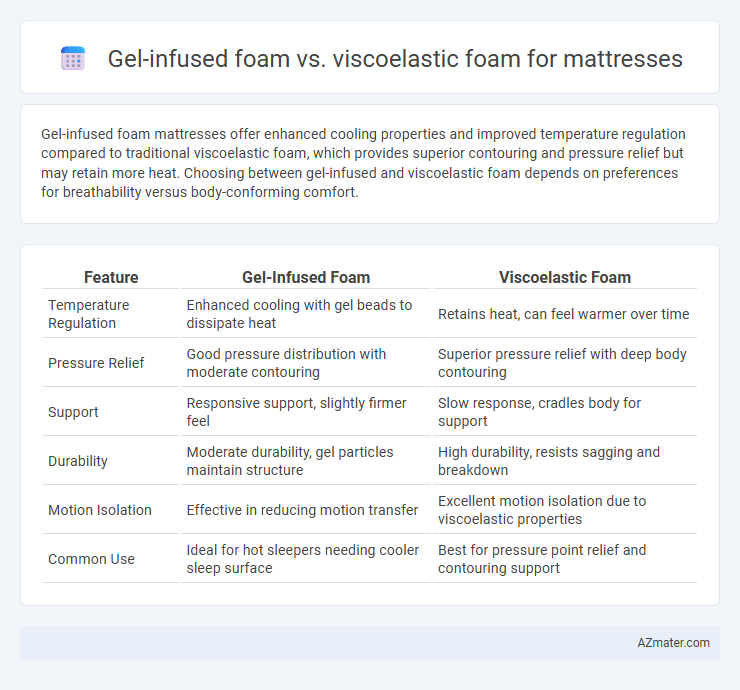Gel-infused foam mattresses offer enhanced cooling properties and improved temperature regulation compared to traditional viscoelastic foam, which provides superior contouring and pressure relief but may retain more heat. Choosing between gel-infused and viscoelastic foam depends on preferences for breathability versus body-conforming comfort.
Table of Comparison
| Feature | Gel-Infused Foam | Viscoelastic Foam |
|---|---|---|
| Temperature Regulation | Enhanced cooling with gel beads to dissipate heat | Retains heat, can feel warmer over time |
| Pressure Relief | Good pressure distribution with moderate contouring | Superior pressure relief with deep body contouring |
| Support | Responsive support, slightly firmer feel | Slow response, cradles body for support |
| Durability | Moderate durability, gel particles maintain structure | High durability, resists sagging and breakdown |
| Motion Isolation | Effective in reducing motion transfer | Excellent motion isolation due to viscoelastic properties |
| Common Use | Ideal for hot sleepers needing cooler sleep surface | Best for pressure point relief and contouring support |
Introduction to Gel-Infused Foam and Viscoelastic Foam
Gel-infused foam incorporates cooling gel beads within the foam matrix to enhance temperature regulation and provide a cooler sleep surface, while viscoelastic foam, commonly known as memory foam, is designed to contour closely to body shape, offering pressure relief and support by responding to heat and weight. Gel-infused foam improves airflow and dissipates heat more efficiently, making it ideal for hot sleepers, whereas traditional viscoelastic foam excels in motion isolation and ergonomic support. Both types optimize comfort, but gel-infused foam advances thermal comfort through enhanced breathability and heat dispersion.
What is Gel-Infused Foam?
Gel-infused foam is a type of memory foam infused with gel beads or swirls designed to enhance heat dissipation and maintain a cooler sleeping surface. Unlike traditional viscoelastic foam, which tends to retain body heat due to its dense structure, gel-infused foam promotes better airflow and temperature regulation, reducing night sweats. This technology improves comfort by combining pressure relief with improved thermal management, making it ideal for hot sleepers.
Understanding Viscoelastic (Memory) Foam
Viscoelastic foam, commonly known as memory foam, is a temperature-sensitive material that molds to the body's shape, providing personalized support and pressure relief. Gel-infused foam incorporates cooling gel beads or layers within the viscoelastic structure to enhance breathability and regulate temperature during sleep. Understanding the viscoelastic properties helps consumers choose between classic memory foam's contouring benefits and gel-infused variants aimed at reducing heat retention for improved sleep comfort.
Temperature Regulation: Gel-Infused vs Viscoelastic Foam
Gel-infused foam mattresses offer superior temperature regulation by dispersing heat away from the body through gel beads embedded in the foam, preventing overheating during sleep. Viscoelastic foam, also known as memory foam, tends to retain body heat more due to its dense structure, which can lead to warmer sleep environments. Choosing gel-infused foam is beneficial for hot sleepers seeking cooler, more breathable mattress options.
Pressure Relief and Body Support Comparison
Gel-infused foam mattresses provide enhanced pressure relief through improved heat dissipation, maintaining a cooler sleep surface while conforming to the body's contours. Viscoelastic foam, or memory foam, excels in body support by evenly distributing weight and reducing pressure points, but can retain heat more than gel-infused variants. Both materials offer significant pressure relief and support, with gel-infused foam balancing temperature regulation and viscoelastic foam prioritizing deep contouring and motion isolation.
Motion Isolation: Gel-Infused Foam vs Viscoelastic Foam
Gel-infused foam excels in motion isolation by dissipating energy and minimizing disturbance from movement, making it ideal for partners with different sleep schedules. Viscoelastic foam, known for its dense, contouring properties, effectively absorbs motion by conforming closely to the sleeper's body, reducing transfer across the mattress surface. Both foams offer superior motion isolation compared to traditional materials, but viscoelastic foam generally delivers a slightly higher level of motion transfer reduction due to its slower response time.
Durability and Longevity of Each Foam Type
Gel-infused foam mattresses typically offer enhanced durability due to their open-cell structure that resists heat buildup and maintains firmness over time. Viscoelastic foam, or memory foam, provides excellent pressure relief but is more prone to sagging and indentations with prolonged use, potentially reducing its lifespan. High-density gel-infused foams generally outperform viscoelastic foams in longevity, sustaining supportive comfort for around 7 to 10 years.
Allergen Resistance and Hypoallergenic Properties
Gel-infused foam mattresses offer superior allergen resistance due to their antimicrobial properties and breathable structure, which inhibits dust mites and mold growth. Viscoelastic foam, while contouring to the body for comfort, tends to retain heat and moisture, potentially fostering allergens unless treated with hypoallergenic covers. Consumers seeking mattresses that minimize allergic reactions often prefer gel-infused foam for its enhanced breathability and inherent antimicrobial benefits.
Price Differences and Value for Money
Gel-infused foam mattresses typically cost 10-20% more than viscoelastic foam mattresses due to the advanced cooling technology integrated into the gel beads. While viscoelastic foam offers excellent pressure relief and body contouring at a lower price point, gel-infused foam provides enhanced temperature regulation, making it a valuable investment for hot sleepers. Evaluating price differences against individual sleep needs and preferences helps determine the best value for money in mattress selection.
Choosing the Right Foam for Your Mattress Needs
Gel-infused foam enhances temperature regulation by dissipating heat better than traditional viscoelastic foam, making it ideal for hot sleepers seeking a cooler mattress experience. Viscoelastic foam, known for its superior contouring and pressure relief, suits individuals with joint pain or those who desire a deeply cradling surface. Selecting the right foam depends on your sleep temperature preference and need for body conformity, with gel-infused foam providing improved airflow and viscoelastic foam offering enhanced support and motion isolation.

Infographic: Gel-infused foam vs Viscoelastic foam for Mattress
 azmater.com
azmater.com